tennis for BEGINNERS
Luckily tennis teaching methods have been steadily catching up to the game we see on the TV. The way the pros play has always seemed so graceful, efficient and effortless, while most traditional tennis lessons will often leave the student feeling like a tennis robot, with a long checklist of instructions to memorize.
Tennis really is as simple as throw and catch – a basic skill most of us started developing at an early age – and a skill tennis lessons should only build upon.
If when trying to catch a ball flying towards you; you stood sideways on, positioned your hand as far away from the ball as possible and had a list of instructions for your feet and body to follow, you would probably fail to catch the ball and feel rather awkward and un-athletic in the process.
When we move to catch a ball it’s a natural thoughtless process. The eyes track the ball. The hand moves to catch it. The body does what it needs to do to make this happen.
The same feeling is needed when we move to hit a tennis ball. Sure you will need some fancy moves to win at the highest levels but you can go a long way on your natural reactions and motor skills.
What you do with your hand around and through the point of contact is the heart of the matter when it comes to learning or remembering how to play tennis.
The movement of your hand/racket-face across the back of the ball (and the arm structure that supports this) is the most important movement in tennis.
Ready positions, take-backs, skip-checks, final steps, knee bends are all important factors, but on their own they will never get a ball over the net… What you do with your hand, arm and racket through the point of contact is the only thing that can.
If you were to perform every aspect of the modern forehand perfectly but the hand comes through without any awareness – at the wrong angle or with an unstable wrist then your hand will ruin everything, and leave you wondering what on earth happened.
On the other hand, if you were to be late to the ball and do everything wrong, with today’s technology and the correct movement of the arm and alignment of the hand you can still hit an effective, even amazing shot.
Thus, the hand can make or break everything else, and should be the first tennis memory and most familiar feeling in tennis.
The Process
The process of developing this feeling is the same for a junior, beginner or frustrated intermediate, whether you are three years old or eighty-three, and the sooner you develop an awareness of this part of your technique the better.
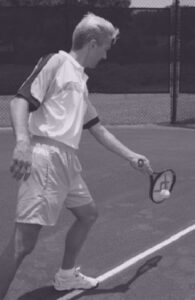
The set-up
- Start yourself (or your student) as close to the ball-feeder as you need to be to make it easy to track and catch a slowly thrown ball.
- You can move your hand up the racket grip, or use two hands if the racket feels heavy. But keep in mind that the goal is to have a very relaxed but firm grip.
- Keep the feet facing forwards in an open-stance – this will keep your hand out in front of the body and close to the ball and contact point naturally from the start.
- The palm of your hand and your racket face should be facing the target area out in front of the body, as if you were reaching for a door handle. A single bend at the wrist or a double bend at the elbow and wrist will help with this alignment.
- No back-swings, wind-ups, ready positions or footwork are necessary in the initial stages, similar to a really friendly game of throw and catch.
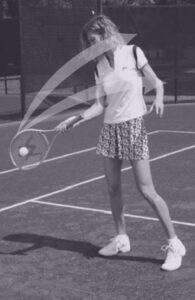
The Action
- Just keep it simple focusing on one thing – the whole movement – from start to finish. Ball to shoulder.
- It’s a lifting, brushing, wiping, skimming, pulling feeling up and across the back of the ball and out in front of the body.
- The arm will naturally bend as the motion moves up and across to the opposite shoulder.
- A stable wrist is key, so try to imagine a half-full plastic cup or small bottle of water is taped to the palm of your hand or the racket-face and it’s heading over the opposite shoulder.
- Keep the feeling that your hand is wiping across a window, while taking care not to splash that imaginary glass of water all over yourself with a wobbly wrist.
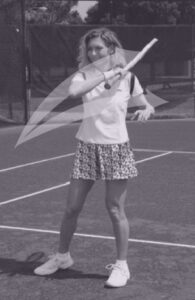
The Finish
- The finish will have your racket butt pointing towards the net, while the elbow has moved from beside the right hip area to around shoulder height out in front of the body.
- The thumb of your racket hand should be finishing in the area of the opposite shoulder.
- The bodyweight will naturally shift from the right foot to the left foot (the opposite for a left-hander).
- Don’t add any distance, movement or difficulties until this feeling is fully automated as the first tennis memory. You don’t even need a net… or a tennis coach to get started.
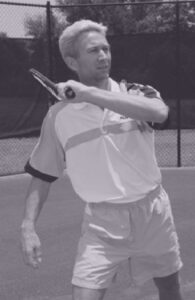
You can get a really good feel for this movement by brushing your hand or racket face up the side of a tennis net focusing on skimming the net band and finishing, or use the tennis court fence as shown below.
The fence is great for practising the brush of the ball on different types of contact points where you might need to be more careful where your hand is facing; high and low balls, or balls too close or far away often need a little more care.
Pick your spot on the fence and brush with one smooth motion 5 to 10 times, then repeat on another spot. If you can consistently skim the exact same spot on the net band or fence with a smooth precise motion then there’s a good chance you will be able to do it to a moving ball.
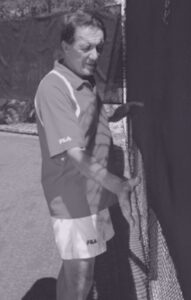
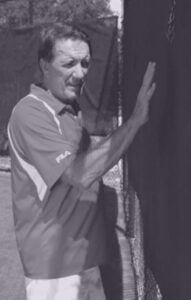
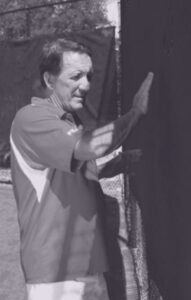
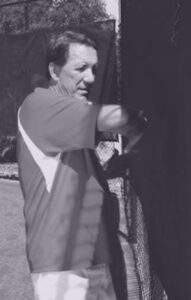
You can fine tune this one simple motion and feeling with the above checklist in mind, without being overwhelmed with lots of different instructions for different body parts to synchronize. Focus on one point at a time.
Once this movement is downloaded into your muscle memory – which only takes a hundred or two repetitions – you can start to add some distance, movement and a ready position.
This can be done one-handed or two-handed in the early stages and I usually recommend a permanent two-handed backhand to everyone unless they are set on the idea of having a one-hander and are prepared to commit to it. The learning curve of these two shots is very different, with easy, immediate and lasting results being possible with the two-hander.
The two-hander also has the huge advantage of being able to go open-stance when necessary or preferred.
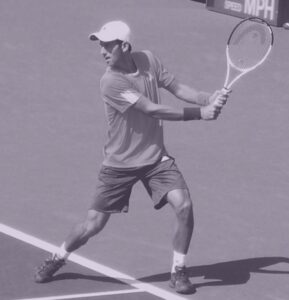 Djokovic – open-stance backhand
Djokovic – open-stance backhandI’ve seen these simple methods work very well for nearly twenty years, with quick results for nearly all my students of all levels and ages.
I’ve also completed countless ‘modern tennis makeovers’ as i call them – where I’ve helped many people transition from a more traditional game after decades of struggling with the speed, height and variety of the modern game.